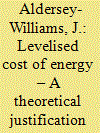| Srl | Item |
| 1 |
ID:
092753


|
|
|
|
|
| Publication |
2009.
|
| Summary/Abstract |
Coal-fired power plants enjoy a significant advantage relative to gas plants in terms of cheaper fuel cost. This advantage may erode (or turn into disadvantage) depending on CO2 emission allowance price. Financial risks are further reinforced when the price of electricity is determined by natural gas-fired plants' marginal costs. We aim to empirically assess the risks in EU coal plants' margins up to the year 2020. Parameter values are derived from actual market data. Monte Carlo simulation allows compute the expected value and risk profile of coal plants' earnings. Future allowance prices may spell significant risks on utilities' balance sheets.
|
|
|
|
|
|
|
|
|
|
|
|
|
|
|
|
| 2 |
ID:
162920


|
|
|
|
|
| Summary/Abstract |
Although widely accepted as a measure of the comparative lifetime costs of electricity generation alternatives, levelised cost of energy (LCOE) lacks a theoretical foundation in the academic literature and encompasses a number of areas where caution is important. Therefore, this paper seeks to provide a theoretical foundation by comparing the metric with alternative cost of energy metrics and by undertaking a brief literature review to describe its strengths and weaknesses. In comparison with other potential measures of unit cost of energy, LCOE is found to be the preferred choice, in large part because of its widespread adoption. The weaknesses of the LCOE are found to centre on discount rate, inflation effects and the sensitivity of results to uncertainty in future commodity costs. These weaknesses are explored in the context of comparing combined cycle gas fired generation and offshore wind in the UK, based on publicly available cost measures. It is found that with variability of future fuel gas prices, and a Monte Carlo approach to modelling LCOE, the range of LCOE for CCGT is much broader in comparison to the LCOE of offshore wind. It is urged that explicit account be taken of the areas of weakness in future use of LCOE.
|
|
|
|
|
|
|
|
|
|
|
|
|
|
|
|
| 3 |
ID:
125738


|
|
|
|
|
| Publication |
2013.
|
| Summary/Abstract |
A Monte Carlo model of the combined GB gas and electricity network was developed to determine the reliability of the energy infrastructure. The model integrates the gas and electricity network into a single sequential Monte Carlo simulation. The model minimises the combined costs of the gas and electricity network, these include gas supplies, gas storage operation and electricity generation. The Monte Carlo model calculates reliability indices such as loss of load probability and expected energy unserved for the combined gas and electricity network. The intention of this tool is to facilitate reliability analysis of integrated energy systems. Applications of this tool are demonstrated through a case study that quantifies the impact on the reliability of the GB gas and electricity network given uncertainties such as wind variability, gas supply availability and outages to energy infrastructure assets. Analysis is performed over a typical midwinter week on a hypothesised GB gas and electricity network in 2020 that meets European renewable energy targets. The efficacy of doubling GB gas storage capacity on the reliability of the energy system is assessed. The results highlight the value of greater gas storage facilities in enhancing the reliability of the GB energy system given various energy uncertainties.
|
|
|
|
|
|
|
|
|
|
|
|
|
|
|
|
| 4 |
ID:
098709


|
|
|
|
|
| Publication |
2010.
|
| Summary/Abstract |
Nations or regions with limited electrical grid and restricted financial resources are a suitable market for small medium power plants with a size of 300-400 MWe. The literature presents several comparisons about the economics of large power plants (of about 1000 MWe); however there are not probabilistic analysis regarding the economics of small medium power plants. This paper fills this gap comparing, with a Monte Carlo evaluation, the economical and financial performances of a nuclear reactor, a coal fired power plant and a combined cycle gas turbine (CCGT) of 335 MWe. The paper aims also to investigate the effect of the carbon tax and electrical energy price on the economics of these plants. The analysis show as, without any carbon tax, the coal plant has the lowest levelised unit electricity cost (LUEC) and the highest net present value (NPV). Introducing the carbon tax the rank changes: depending on its amount the first and the nuclear after becomes the plant with lower LUEC and highest NPV. Therefore, the uncertainty in the carbon tax cost increases the risk of investing in a coal plant above the level of the new small medium reactor.
|
|
|
|
|
|
|
|
|
|
|
|
|
|
|
|